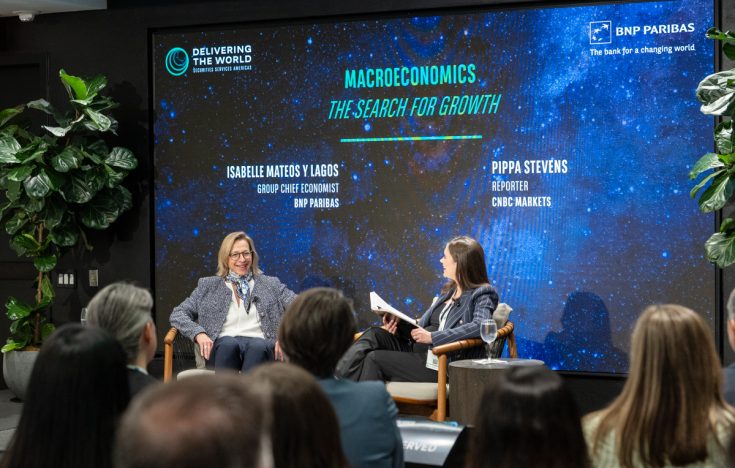For its annual “Delivering the World” flagship client event held on June 9 at Nasdaq’s New York headquarters, BNP Paribas Securities Services offered a comprehensive look at macroeconomic trends, as well as the essential investments in market infrastructure, to better handle increased complexity and opportunities around clearing, digital currency and data flows. And while plans for an expanded 24/5 trading cycle will go a long way toward meeting investor demand, they also raise questions about available liquidity and the possibility for heightened volatility, noted panelists.
Macro trends
On the topic of tariffs, Isabelle Mateos y Lago, Chief Economist for BNP Paribas, told moderator Pippa Stevens of CNBC Markets that the current US administration has impacted the rules of economic order in ways faster than anyone anticipated. “While the administration’s protectionist agenda was not a surprise, it was the speed and scale of the tariff rollouts that has certainly defied what people expected,” remarked Mateos y Lago.
While the U.S. economy continues to show resilience, ongoing uncertainty around trade policy has created headwinds. At the same time, Mateos y Lago pointed to growing momentum in other regions, particularly in Europe, where strengthened trade alliances and greater policy cohesion are presenting fresh opportunities for long-term growth.
“The US is still far and away the leader in innovation and deployment of AI, with China the only other country that comes close,” said Mateos y Lago.
That said, the possibility of recession remains off the table for the time being. “Even with growth forecasts revised downward, we shouldn’t underestimate the continued resilience of the U.S. economy, which still has momentum on its side,” she said. “However, knowing that the tariff rates could be raised again is cause for concern.”
Is the EU looking more attractive in this climate? Investors are now waking up to the opportunity—and the UK is well-positioned after looking inward for quite some time and is now mending ties with the EU, said Mateos y Lago. Meanwhile emerging markets like Latin America are also looking more positive, she added.
Infrastructure to the fore
Philippe Benoit, BNP Paribas’ Head of Strategic Business, Development & Transformation, wondered how the industry is weathering market dynamics year to date. Frank La Salla, CEO of the Depository Trust and Clearing Corporation (DTCC), suggested that the current environment is in fact one of the most potent the industry has seen in years, due to the continued rise of AI, blockchain and other technologies.
Speaking to the market volatility that has impacted equities of late, La Salla noted how the substantial uptick in trade and liquidity volumes has caused the markets to adopt a heightened sense of urgency around resiliency. According to La Salla, the modernization undertaken by DTCC member firms has paid off handily during this period, allowing companies to process an unprecedent number of trades in a T+1 environment. Underscoring the importance of running at a leaner T+1 settlement cycle, La Salla pointed out how the firm’s NSCC Clearing Fund was able to return some US$4bn daily to the industry simply by cutting the cycle in half.
Last year’s adoption of T+1 by S.D. Indeval, Mexico’s central securities depository, brought that country’s settlement system into alignment with the rest of North America, and its roll-out went even better than planned, concurred Indeval CEO Roberto Gonzalez. Post-T+1 the industry is more efficient and less expensive, said Gonzalez, while fail rates have barely registered under T+1, he said.
Countdown to 24/5
In March, Nasdaq announced plans to roll out 24-hour/5-days-a-week trading capability on its platform, with a launch date pegged for the second half of next year, pending regulatory approval. Tal Cohen, President, Nasdaq, cited a number of indicators fueling demand for 24/5, chief among them increased foreign interest in domestic investments.
The speed with which the 24/5 phenomenon has hit the markets speaks volumes for this rise in demand, affirmed DTCC’s La Salla, whose NSCC Clearing Fund will be ready for 24/5 trading by Q2 of 2026. At the same time, La Salla voiced some concern over the extraordinary trading volumes and subsequent need for commensurate liquidity to avoid major market dislocations, particularly around off-hours news events.
Quelling complexity
Meanwhile, complexity continues to be the main watchword for clients, reports Cohen, compelling them to seek better ways of managing counterparty and operational risk through automation, in addition to staying in step with regulatory reforms. Research indicates that global banks are spending some US$250bn annually on risk and compliance functions[1] to help contain complexity which is an enormous sum, said Cohen, and underscores the value of reducing risk scenarios over the long haul.
Clients are also asking for a modernization blueprint, whether innovating through AI, blockchain, or moving to the cloud. Being a market operator in the current environment is a valuable commodity, said Cohen, particularly for clients seeking better business models, or becoming a platform business to fully embrace data for the benefit of their customers.
The key to successful modernization, then, is to avoid disrupting clients, assure people they can continue to use what they’ve built, but to also be transparent with regulators and customers, said Cohen, making sure they understand the benefits to them as well, whether through greater resilience or improved performance. Going forward, Cohen is optimistic that the industry will continue to adapt to new challenges and the opportunities that lie within, be it T+1 or emerging technologies, like AI, capable of rapidly changing the face of the markets.
